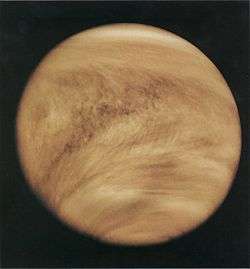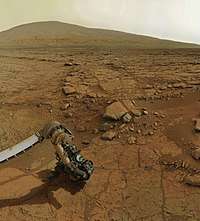Life on Venus
The speculation of life currently existing on Venus decreased significantly since the early 1960s, when spacecraft began studying the planet and it became clear that its environment is extreme compared to Earth's.

 |
| This article is one of a series on: |
| Life in the Universe |
|---|
| Astrobiology |
| Habitability in the Solar System |
| Life outside the Solar System |
Venus's location closer to the Sun than Earth and the extreme greenhouse effect raising temperatures on the surface to nearly 735 K (462 °C; 863 °F), and the atmospheric pressure 90 times that of Earth, make water-based life as we know it unlikely on the surface of the planet. However, a few scientists have speculated that thermoacidophilic extremophile microorganisms might exist in the temperate, acidic upper layers of the Venusian atmosphere.[1][2][3]
Historical views
Until the mid 20th century, the surface environment of Venus was believed to be similar to Earth, hence it was widely believed that Venus could harbor life. In 1870, the British astronomer Richard Proctor said the existence of life on Venus was impossible near its equator,[4] but possible near its poles.
Since the 1960s, increasingly clear evidence from various space probes showed Venus has an extreme climate, with a greenhouse effect generating a constant temperature of about 500 °C (932 °F) on the surface. The atmosphere contains sulfuric acid clouds and the atmospheric pressure at the surface is 90 bar, almost 100 times that of Earth and similar to that of more than 1,000 m (3,300 ft) deep in Earth's oceans. In such an environment, and given the increasingly hostile characteristics of the Venusian weather, life as we know it is highly unlikely to occur.
In September 1967, Carl Sagan and Harold Morowitz published an analysis of the issue of life on Venus in the journal Nature.[5]
Habitability of its atmosphere
Although there is little possibility of existing life near the surface of Venus, the altitudes about 50 km (31 mi) above the surface have a mild temperature, and hence there are still some opinions in favor of such a possibility in the atmosphere of Venus.[6][7]
In the analysis of mission data from the Venera, Pioneer Venus and Magellan missions, it was discovered that carbonyl sulfide, hydrogen sulfide and sulfur dioxide were present together in the upper atmosphere. Venera also detected large amounts of toxic chlorine just below the Venusian cloud cover.[8] Carbonyl sulfide is difficult to produce inorganically,[7] but it can be produced by volcanism.[9] Sulfuric acid is produced in the upper atmosphere by the Sun's photochemical action on carbon dioxide, sulfur dioxide, and water vapour.[10]
Solar radiation constrains the atmospheric habitable zone to between 51 km (65 °C) and 62 km (−20 °C) altitude, within the acidic clouds.[3] It has been speculated that clouds in the atmosphere of Venus could contain chemicals that can initiate forms of biological activity.[11][12] It has been speculated that any hypothetical microorganisms inhabiting the atmosphere, if present, could employ ultraviolet light (UV) emitted by the Sun as an energy source, which could be an explanation for the dark lines (called "unknown UV absorber") observed in the UV photographs of Venus.[13][14] The existence of this "unknown UV absorber" prompted Carl Sagan to publish an article in 1963 proposing the hypothesis of microorganisms in the upper atmosphere as the agent absorbing the UV light.[15]
In August 2019, astronomers reported a newly discovered long-term pattern of UV light absorbance and albedo changes in the atmosphere of Venus and its weather, that is caused by "unknown absorbers" that may include unknown chemicals or even large colonies of microorganisms high up in the atmosphere.[16][17]
In January 2020, astronomers reported evidence that suggests Venus is currently volcanically active, and the residue from such activity may be a potential source of nutrients for possible microorganisms in the Venusian atmosphere, according to researchers.[18][19][20]
Past habitability potential
It's plausible that if liquid water existed on its surface before the runaway greenhouse effect heated the planet, microbial life may have formed on Venus, but it would no longer exist.[21] Assuming the process that delivered water to Earth was common to all the planets near the habitable zone, it has been estimated that liquid water could have existed on its surface for up to 600 million years during and shortly after the Late Heavy Bombardment, which could be enough time for simple life to form, but this figure can vary from as little as a few million years to as much as a few billion.[22][23][24][25][26] Recent studies from September of 2019 concluded that Venus may have had surface water and a habitable condition for around 3 billion years and may have been in this condition until 700 to 750 million years ago, if correct this would give life an ample amount of time to evolve.[27] This might also have given enough time for microbial life to evolve to be aerial.[28]
It has even been suggested that complex life evolved earlier on Venus than on Earth, and that during the Cambrian and Ordovician periods organisms from Venus were transferred to Earth via asteroids. This theory could fit the pattern of pulses of highly developed life appearing, diversifying and going extinct with astonishing rapidity through the Cambrian and Ordovician periods, and also explains the extraordinary genetic variety which appeared over this period.[29]
There has been very little analysis of Venusian surface material, so it is possible that evidence of past life, if it ever existed, could be found with a probe capable of enduring Venus's current extreme surface conditions,[5][30] although the resurfacing of the planet in the past 500 million years[31] means that it is unlikely that ancient surface rocks remain, especially those containing the mineral tremolite which, theoretically, could have encased some biosignatures.[30]
See also
- All Summer in a Day – short story by Ray Bradbury
- Colonization of Venus – Proposed colonization of the planet Venus
- Life on Enceladus
- Life on Europa
- Life on Mars – Scientific assessments on the microbial habitability of Mars
- Life on Titan – Scientific assessments on the microbial habitability of Titan
References
- Clark, Stuart (26 September 2003). "Acidic clouds of Venus could harbour life". New Scientist. Retrieved 30 December 2015.
- Redfern, Martin (25 May 2004). "Venus clouds 'might harbour life'". BBC News. Retrieved 30 December 2015.
- Dartnell, Lewis R.; Nordheim, Tom Andre; Patel, Manish R.; Mason, Jonathon P.; et al. (September 2015). "Constraints on a potential aerial biosphere on Venus: I. Cosmic rays". Icarus. 257: 396–405. Bibcode:2015Icar..257..396D. doi:10.1016/j.icarus.2015.05.006.
- Proctor, Richard A., Other Worlds Than Ours: The Plurality of Worlds Studied Under the Light of Recent Scientific Researches. New York : J.A. Hill and Co., 1870. s. 94.
- Morowitz, Harold (2011). "Life on Venus". Astrobiology. 11 (9): 931–932. Bibcode:2011AsBio..11..931M. doi:10.1089/ast.2011.9270. PMID 22059693 – via Academic OneFile.
- Venus as a Natural Laboratory for Search of Life in High Temperature Conditions: Events on the Planet on March 1, 1982 Archived 7 November 2015 at the Wayback Machine, L. V. Ksanfomality, published in Astronomicheskii Vestnik, Vol. 46, No. 1, 2012 Archived 4 March 2016 at the Wayback Machine.
- Landis, Geoffrey A. (2003). "Astrobiology: the Case for Venus" (PDF). Journal of the British Interplanetary Society. 56 (7/8): 250–254. Bibcode:2003JBIS...56..250L. Archived from the original (PDF) on 7 August 2011.
- David Harry Grinspoon (1997). Venus Revealed: A New Look Below the Clouds of Our Mysterious Twin Planet. fdffdsdasfdfgjhkjlkuytdsfghjkl;Addison-Wesley Pub. ISBN 978-0-201-40655-9.
- Seinfeld, J. (2006). Atmospheric Chemistry and Physics. London: J. Wiley. ISBN 978-1-60119-595-1.
- "Venus Express: Acid clouds and lightning". European Space Agency (ESA). Retrieved 8 September 2016.
- David, Leonard (11 February 2003). "Life Zone on Venus Possible". Space.com. Archived from the original on 16 February 2003. Retrieved 30 December 2015.
- Schulze-Makuch, Dirk; Grinspoon, David H.; Abbas, Ousama; Irwin, Louis N.; Bullock, Mark A. (March 2004). "A Sulfur-Based Survival Strategy for Putative Phototrophic Life in the Venusian Atmosphere". Astrobiology. 4 (1): 11–18. Bibcode:2004AsBio...4...11S. doi:10.1089/153110704773600203. PMID 15104900.
- "Venus could be a haven for life". ABC News. 28 September 2002. Retrieved 30 December 2015.
- Schulze-Makuch, Dirk; Irwin, Louis N. (5 July 2004). "Reassessing the Possibility of Life on Venus: Proposal for an Astrobiology Mission". Astrobiology. 2 (2): 197–202. Bibcode:2002AsBio...2..197S. doi:10.1089/15311070260192264. PMID 12469368.
- Mysterious dark patches in Venus' clouds are affecting the weather there. What the dark patches are is still a mystery, though astronomers dating back to Carl Sagan have suggested they could be extraterrestrial microorganisms. Erica Naone, Astronomy. 29 August 2019.
- Anderson, Paul (3 September 2019). "Could microbes be affecting Venus' climate? – Unusual dark patches in Venus' atmosphere – called "unknown absorbers" – play a key role in the planet's climate and albedo, according to a new study. But what are they? That's still a mystery". Earth & Sky. Retrieved 3 September 2019.
- Lee, Yeon Joo; et al. (26 August 2019). "Long-term Variations of Venus's 365 nm Albedo Observed by Venus Express, Akatsuki, MESSENGER, and the Hubble Space Telescope". The Astronomical Journal. 158 (3): 126–152. arXiv:1907.09683. Bibcode:2019AJ....158..126L. doi:10.3847/1538-3881/ab3120.
- Hall, Sannon (9 January 2020). "Volcanoes on Venus Might Still Be Smoking - Planetary science experiments on Earth suggest that the sun's second planet might have ongoing volcanic activity". The New York Times. Retrieved 10 January 2020.
- Filiberto, Justin (3 January 2020). "Present-day volcanism on Venus as evidenced from weathering rates of olivine". Science. 6 (1): eaax7445. Bibcode:2020SciA....6.7445F. doi:10.1126/sciadv.aax7445. PMC 6941908. PMID 31922004.
- Limaye, Sanjay S. (12 September 2018). "Venus' Spectral Signatures and the Potential for Life in the Clouds". Astrobiology. 18 (9): 1181–1198. Bibcode:2018AsBio..18.1181L. doi:10.1089/ast.2017.1783. PMC 6150942. PMID 29600875.
- Bruce Dorminey, "Venus Likely Had Past Life; Next Step Is Finding It", Forbes, 28 March 2016.
- "Was Venus once a habitable planet?". European Space Agency. 24 June 2010. Retrieved 22 May 2016.
- Nancy Atkinson (24 June 2010). "Was Venus once a waterworld?". Universe Today. Retrieved 22 May 2016.
- Henry Bortman (26 August 2004). "Was Venus Alive? 'The Signs are Probably There'". Space.com. Retrieved 22 May 2016.
- "NASA Climate Modeling Suggests Venus May Have Been Habitable". NASA.gov. NASA. 11 August 2016. Retrieved 15 August 2016.
- Michael J. Way (2 August 2016). "Was Venus the First Habitable World of our Solar System?'". Geophysical Research Letters. 43 (16): 8376–8383. arXiv:1608.00706. Bibcode:2016GeoRL..43.8376W. doi:10.1002/2016GL069790. PMC 5385710. PMID 28408771.
- "Venus May Have Been Habitable for Three Billion Years | Planetary Science | Sci-News.com". Breaking Science News | Sci-News.com. Retrieved 24 September 2019.
- "Did the Early Venus Harbor Life? (Weekend Feature)". The Daily Galaxy. 2 June 2012. Archived from the original on 28 October 2017. Retrieved 22 May 2016.
- Cartwright, Annabel (2016). "The Venus Hypothesis". arXiv:1608.03074 [astro-ph.EP].
- David Shiga (10 October 2007). "Did Venus's ancient oceans incubate life?". New Scientist. Retrieved 22 May 2016.
- Strom, Robert G.; Schaber, Gerald G.; Dawson, Douglas D. (25 May 1994). "The global resurfacing of Venus". Journal of Geophysical Research. 99 (E5): 10899–10926. Bibcode:1994JGR....9910899S. doi:10.1029/94JE00388.